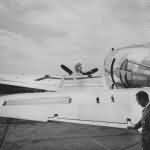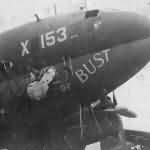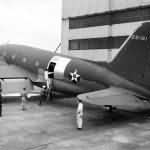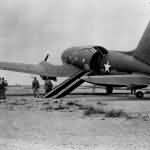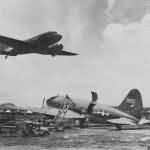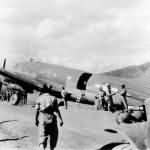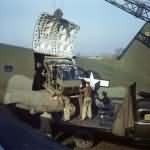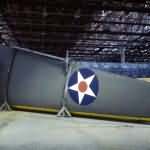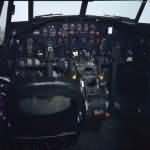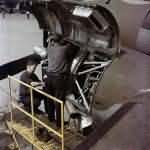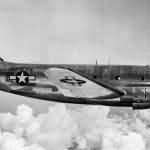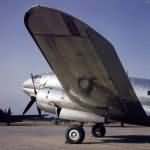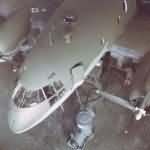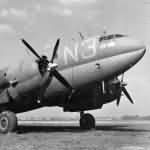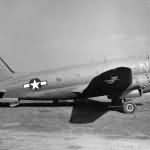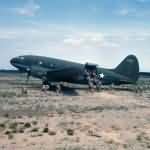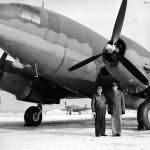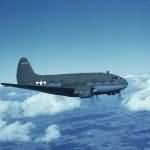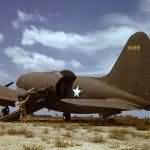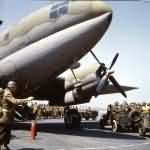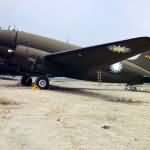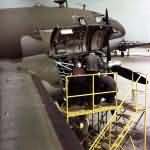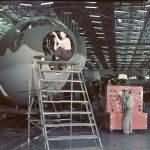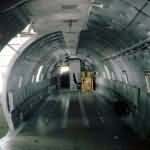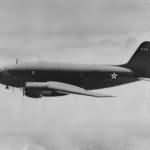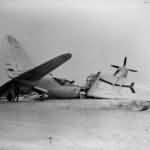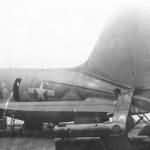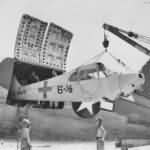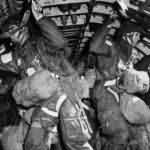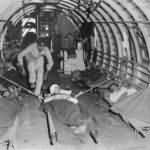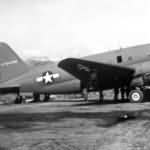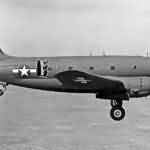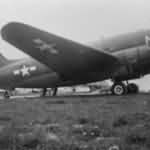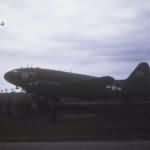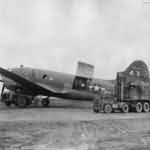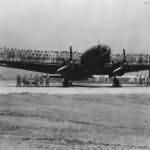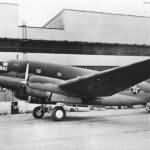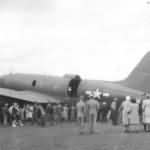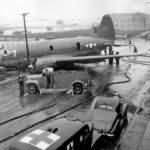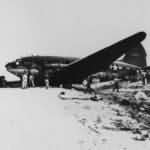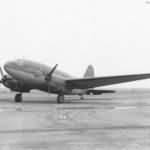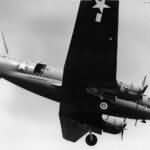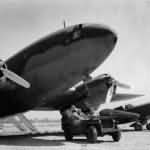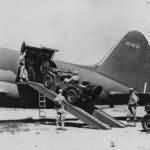C-46 horizontal stabilizer and elevator 1943
C-46 of the 375th TCG, nose art Tokyo or BUST
C-46A 41-25161 at Buffalo factory
C-46A 41-5159 1942 2
C-46A 41-5159 1942 in flight 3
C-46A 41-5159 1942 in flight 4
C-46 41-5163 with parallel vehicle ramp
Maintenance on P&W R-2800 engine of C-46
C-46A 320 of the 433rd TCG, 67thy TCS
C-46A and P-40 assembly line 3
C-46A 41-24755 after hitting Dakota IV KN220 436 Squadron Chittagong 19 March 1945
C-46 rolls out of Curtiss factory
C-46A assembly line 4
C-46A-10 41-12338 in flight
C-46A 41-12375, 41-12378, 41-12377 and P-40
C-46 at modification center
Airmen load Sikorsky R-4 into a C-46 41-24719
C-46A 43-47313 in flight
C-46D – paratroop transport aircraft, fitted with an extra door on the port side
C-46 wing
Soldiers waiting to board the C-46A
C-46A 42-96621 2
C-46 cockpit 2
C-46D 44-78120 3
C-46 42-107363
C-46D 44-78120 5
C-46A assembly line 2
C-46A engine 4
C-46A 42-96803 2
C-46A 42-96803 in flight
C-46A wing
C-46A final assembly line at Curtiss’ Buffalo factory
C-46D 44-77519 N3-K of the 313th TCG, 47 TCS, ETO
C-46D 44-77519 N3-K of the 313th Troop Carrier Group, 47th TCS, ETO
Soldiers are exiting the C-46 41-5166
C-46A 42-96803 3
C-46E 2
C-46A assembly line
Early C-46
C-46A 41-24703 in flight
U.S. Military transport aircraft C-46A 41-24703 2
Loading a Jeep onto a C-46 41-5166 2
Brand new C-46E, 1945
C-46 at factory airfield
C-46A CBI
C-46E 43-47403 July 1945
P-40 and C-46, Curtiss plant 1944
C-46D 44-78120 fitted with an extra door on the port side
C-46 42-107363 2
Tail of C-46A 42-96535
C-46A 41-24772, Curtiss Buffalo factory
Soldiers waiting to board the C-46A 2
C-46F 44-78627 for China, 1945
C-46A in flight
C-46E 3
C-46A engine
Curtiss C-46A 43-46994 India
The instrument panel in the cockpit of a C-46
Curtiss C-46A engine 3
C-46A wing 2
C-46E 43-47403, front view
Curtiss C-46A warming up engines
C-46 engine
C-46A final assembly line 2
Pratt & Whitney R-2800 Double Wasp engine
Interior of a C-46
C-46A 41-5159 in flight 1942
C-46 “Southern Belle” of the 313th Troop Carrier Group
Marine R5C-1 destroyed by Japanese Paratroops Yontan Airfield 1945
C-46 and Jeep PTO
Flight crews unload Piper AE-1 30289 from a C-46 at Peleliu
Paratroopers jumping from C-46D 44-77524 of the 437th TCG
17th Airborne Troops Jump from C-46, Operation Varsity 24 March 1945
C-46A 42-96621 in flight
Wounded evacuated aboard C-46 of the 1st Air Commando Group in Burma
R5C of the VMR-952 taxis on the runway at Yontan Okinawa in April 1945
C-46D code X144 of the 375th TCG, Pacific 1945
C-46D 44-78109 in flight
C-46A 42-107343 Agadir
C-46 PTO 2
C-46A of the N3-O 47th TCS, 313 Troop Carrier Group
C-46D W7-AD 44-77686 of the 316th Troop Carrier Group
C-46 PTO
C-46 in flight
Paratroopers jumping from a C-46 44-77548 H2-L of 313th TCG 2
Curtiss C-46 in flight
Loading C-46A 41-12413 to flight to China over Hump 44
C-46 Q8-D of the 349th Troop Carrier Group
100 soldiers on wings of Curtiss C-46 1943
C-46D 44-77548 H2-L of 313th Troop Carrier Group
C-46 of the 313th TCG England
Early C-46 during tests at Curtiss-Wright Factory Buffalo
Curtiss C-46D 44-78032
C-46 and P-40 on Assembly Line in Curtiss Plant 1942
C-46D 44-77541 N3-A of the 313th TCG, 47th Squadron 1945
Crashed C-46D #7 1944
Crashed C-46A 42-101159 X619 of 2nd CCG, October 1945
Crashed C-46
Curtiss C-46 assembly line
C-46A 41-5160
Curtiss C-46D 44-78109 2
C-46 #3 PTO November 1943
Jeep beside Curtiss C-46 Commando and P-40 Warhawk
Loading Jeep onto C-46A 41-5163
Commando was a transport aircraft originally derived from a commercial high-altitude airliner design. It was instead used as a military transport during World War II by the United States Army Air Forces as well as the U.S. Navy/Marine Corps under the designation R5C. Known to the men who flew them as “The Whale,” or the “Curtiss Calamity,” the C-46 served a similar role as its counterpart, the Douglas C-47 Skytrain, but was not as extensively produced.
Design and Structure
- Type: Twin-engine transport aircraft designed for cargo, troop transport, and specialized missions.
- Wings:
- Configuration: Low-wing cantilever monoplane with all-metal construction, divided into three sections: a rectangular center-section and two tapering outer sections with detachable tips.
- Structure: The center-section features three built-up spars with extruded flanges, girder-type ribs, and a stressed skin of 24ST Alclad with spanwise hat-shaped stiffeners. Outer sections include two spars, girder-type ribs (with special web-type ribs near the roots), and a similar stressed skin. The leading edges feature flush riveting back to about one-third of the chord.
- Flaps and Ailerons: Hydraulically-operated flaps are present in the center and outer sections, inboard of the ailerons. Ailerons are dynamically and statically balanced, with metal-covered noses, stamped ribs, and fabric covering.
- Fuselage:
- Construction: All-metal semi-monocoque structure in four sections, with a cross-sectional shape formed by two intersecting circles. The structure includes a series of transverse rings, bulkheads, and longitudinal stringers, covered with smooth 24ST Alclad skin. Flush riveting is used in drag-sensitive areas.
- Tail Unit:
- Type: Cantilever monoplane with all-metal construction, featuring detachable tips on all surfaces. The tailplane consists of two interchangeable sections with three beams each. Elevators and rudder are dynamically balanced and equipped with trim-tabs.
Landing Gear
- Type: Retractable, consisting of Cleveland “Aerol” oleo-pneumatic shock-absorber struts. The landing gear retracts into the nacelles, with hydraulically-operated fairing doors that close after the gear is retracted. The tail-wheel is fully retractable and shimmy-dampened.
Power Plant
- Engines: Two Pratt & Whitney R-2800-51 Double Wasp eighteen-cylinder radial air-cooled engines, each delivering 2,000 hp.
- Propellers: Curtiss Electric four-bladed constant-speed full-feathering airscrews, with a diameter of 13 ft. 6 in. (4.12 m).
- Fuel System: Includes three self-sealing fuel tanks in each outer wing section, totaling 1,400 U.S. gallons, with an additional 800 U.S. gallons in eight fuselage tanks for long-range missions. Each engine has a separate oil system with a 40 U.S. gallon tank.
Accommodation and Cargo
- Cockpit: Accommodates a pilot, co-pilot, navigator, and radio operator. A door connects the cockpit with the main cargo compartment.
- Cargo Compartment:
- Dimensions: 48 ft. (14.6 m) long, 9 ft. 10 in. (3 m) wide, and 6 ft. 8 in. (2 m) high, with a capacity of 2,300 cu. ft. (69 cu. m.).
- Loading Door: Main loading door on the port side, measuring 8 ft. (2.4 m) wide and 6 ft. (1.8 m) high, divided vertically and positioned to facilitate level loading. Additional smaller openings are present for ventilation and access.
- Capacity: Can accommodate 40 fully-armed troops, 33 stretcher cases, or other cargo equivalent to five Wright R-3350 engines. There are additional cargo spaces beneath the main floor, accessible from the ground.
Performance
- Dimensions:
- Span: 108 ft. 1 in. (32.9 m)
- Length: 76 ft. 4 in. (23.3 m)
- Height: 21 ft. 9 in. (6.6 m)
- Wing Area: 1,360 sq. ft. (126.3 sq. m)
- Weights and Loadings:
- Empty Weight: 29,483 lbs. (13,385 kg)
- Normal Loaded Weight: 45,000 lbs. (20,430 kg)
- Maximum Overloaded Weight: 50,000 lbs. (22,700 kg)
- Performance (at 45,000 lbs. loaded weight):
- Maximum Speed: 265 mph (424 km/h) at 13,000 ft. (3,965 m)
- Cruising Speed: 227 mph (363.2 km/h) at 10,000 ft. (3,050 m)
- Climb to 10,000 ft.: 13.5 minutes
- Service Ceiling: 24,500 ft. (7,470 m)
- Service Ceiling (one engine): 12,000 ft. (3,660 m)
This aircraft was designed for versatility in cargo and personnel transport, with a robust structure and advanced features for its time.
